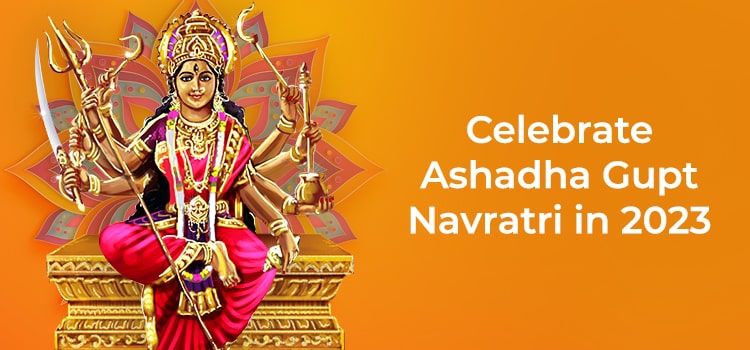Ashada Navratri 2023 : Rules , Rituals and Its Benefits
Ashada Navaratri is one of the 4 Navratris in a year. Navratri festivals are dedicated to the Mother Goddess. While Chaitra Navratri and Sharad Navratri are more well-known and widely celebrated, the other 2 Navratris – Ashada Navratri and Magha Navratri – are not that well-known. They are also called Gupt Navratris, as the worship takes place in secret. Guot Navratris are more popular among those practicing Tantra and sadhana. The belief is that worshipping the Goddess during these times can benefit these practitioners, as they can gain occult powers.
Ashada Navratri has many other names. In the southern states of India, like Tamil Nadu, Kerala, Karnataka, and Andhra Pradesh, it is called Varahi Navratri. Goddess Varahi is one of the Sapta Matrikas and the Shakti of Varaha, the boar incarnation of Vishnu. She is a boar-faced warrior goddess who helped Goddess Durga in her battle against demons.
During Ashada Navratri, devotees also worship the Dasa Mahavidyas or the 10 wisdom goddesses. These goddesses can bestow many siddhis (powers) when they are pleased. The 10 wisdom goddesses are Kali, Tara Devi, Tripurasundari, Bhuvaneshwari, Chinnamasta, Tripura Bhairavi, Dhumavati, Bagalamukhi, Matangi, and Kamala Devi.

In the Kanakadurga temple, Vijayawada (Andhra Pradesh), this festival is celebrated as Shakambari Utsavam. It is dedicated to Goddess Kanakadurga' who is revered as Shakambari Mata. At the Hanamkonda Bhadrakali temple in Warangal, Andhra Pradesh, devotees celebrate it as Bhadrakali Navratri. In Himachal Pradesh, it is Guhya Navratri. Guhya means ‘secret’ or ‘hidden’.
Ashada Navratri rituals and worship take place in an atmosphere of utmost secrecy. The devotees are not supposed to discuss or disclose to others about the worship because it involves Tantra and sadhana practices for gaining occult powers. On the 9 days of the festival, sadhaks perform powerful Tantrik rituals for Shatkarma tantrik prayog (Vashikaran, Shantikaran, Uchadan, Videshan, Sthamban, and Maran).
Ashada Navratri 2023 starts on June 19 and ends on June 27. The festival occurs in Shukla Paksha of Ashada month (June-July).
Devotees who practice Tantra vidya observe vrat or fast during Ashada Navratri to invoke the Goddess’ blessings to fulfill their desires. They also learn the 10 Mahavidyas that are associated with Tantra Shakti. They worship the 9 forms of Durga (Shailaputri, Brahmacharini, Chandraghanta, Kushmanda, Skandamata, Katyayani, Kalaratri, Mahagauri, and Siddhidhatri) who are worshipped during all 4 Navratris, as well as the10 Dasa Mahavidyas.
Ashada Navratri Rituals
∙ Perform Pooja on all days to the Mother Goddess in a designated area. Avoid non-veg food. Do not drink or smoke.
∙ Ghatasthapana, or growing wheat or barley, is not essential, but if you want, you can do it.
∙ The worship of Goddess Varahi is very important.
∙ Take a bath in the morning. Perform a simple Pooja in the morning and evening daily. Complicated rituals and Poojas are not essential.
∙ Provide food to the poor, if possible. Also, give food to animals.
∙ Perform the Pooja and worship by sitting on a red-colored cloth.
∙ Those who wish to gain siddhi and Moksha should sit on a seat of Kusha or Durva grass.
∙ Use a lamp made of gold, silver or gunmetal for Poojas and prayers.
∙ Light the lamp using cow ghee.
∙ Light a single wick. If you plan to perform an important Pooja with all rituals, light 9 wicks.
∙ Offer red hibiscus flower (Gudhal)
∙ Chant prayers and Mantra using mala with beads of red sandalwood or rudraksha.
∙ Prepare and offer a simple bhog like kichadi. Share it with family members and neighbors after the Pooja. You can also offer a fruit.
Benefits of Observing Ashada Navratri
∙ Shakti Upasana, or Mother Goddess worship, during this period, bestows a regular flow of grains and wealth.
∙ People who seek a name in politics and power can realize their desires.
∙ It brings the blessings of the Mother Goddess and auspiciousness in life.
∙ One gains rewards by performing sadhana during this period.
∙ Prayers and Poojas that one performs now can help one overcome evil eye, witchcraft, black magic, etc.
∙ The worship removes illness and bad luck.
Dos and Don’ts during Ashada Navratri
People doing Sadhana and Pooja during Gupt Navratri have to follow certain rules. Here are the dos and don’ts of Ashada Navratri.
∙ Those doing Pooja and vrat during Gupt Navratri must not wear or use any leather items.
∙ Avoid anger, jealousy, lust and desire.
∙ Avoid cutting hair during this period.
∙ Do not cut nails during this period.
∙ Do not perform Mundan Sanskar. Even family members should avoid it.
∙ Do not wear black clothes.
∙ Do not sleep during the daytime.
∙ Small children, old people, pregnant women, and those with serious illnesses should not observe a strict vrat.
∙ Perform Pooja of young girls as it is meritorious.
∙ Read Durga Saptashati or Durga Saptashloki on all 9 days.



















